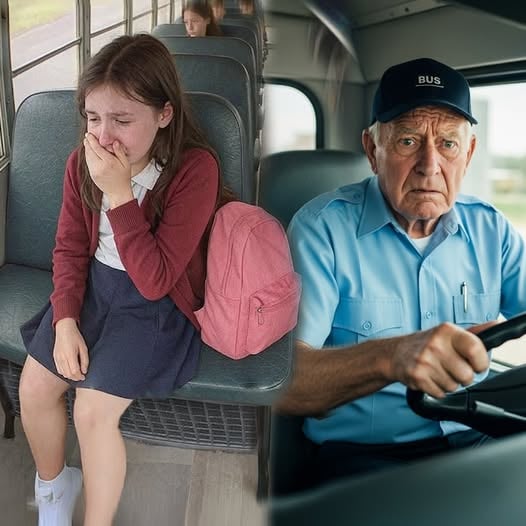John Miller and the Silent Cry of a Child
John Miller had been driving a school bus in Cedar Falls for nearly fifteen years. In all that time, he thought he had seen it all—children laughing, teasing one another, sneaking candy when he wasn’t looking, or dozing off against the cold bus windows during the morning chill. Each day was a rhythm he knew by heart: the chatter, the scuffles, the familiar complaints of “Are we there yet?” But over the course of two unusually quiet weeks, one child’s silence began to gnaw at him in a way he couldn’t ignore.
Emily Parker, ten years old, always slipped into the same seat—row four, on the left side. Her gaze was downcast, and her greeting was barely a whisper. She never caused a fuss, never drew attention to herself, yet something in the way she sat made John pause. It wasn’t her silence alone, but the shadow behind it—the subtle trembling, the avoidance of eye contact. At drop-off, he would often catch a glimpse of her brushing tears away, her small hands hurried, her face red, trying to hide the pain from anyone who might notice. At first, he convinced himself it was just a rough morning here and there. But when it became routine, his heart—and his conscience—would not allow him to look the other way.
One Thursday afternoon, as he checked the bus for forgotten backpacks and lunchboxes, John noticed a folded scrap of paper tucked deep into Emily’s seat. Curiosity and concern made him open it. Written in shaky, uneven pencil were the words:
“I don’t want to go home.”
John’s hands shook as he held the note. The father in him, the human in him, understood immediately: this was more than a simple complaint. This was a cry for help.
The next day, another note appeared: “Please don’t tell. He gets angry.”
And then, a third: “I don’t feel safe at home.”
It was at that moment John realized that silence was no longer just something to notice—it could be dangerous to ignore. He took the notes directly to the school counselor and principal. Within hours, child protection services were involved. When Emily was brought quietly into the counselor’s office, her story came out in trembling fragments: her stepfather’s violent temper had turned her home into a place of fear. The notes hidden in her bus seat were her only way to communicate, her only lifeline to safety.
Authorities acted swiftly. Emily was placed with her grandmother while the case was investigated. Her mother, tearful but relieved, later thanked John: “I don’t know what would have happened if you hadn’t paid attention.”
Weeks later, Emily returned to the bus with lighter shoulders. She began to talk—not just polite small talk, but genuine chatter about books, art projects, and small joys that any child should have the freedom to share. And John drove differently now. Every mile, every turn carried weight. He knew how easy it is to overlook quiet tears, but he also knew the profound power of attentive eyes and the courage to act.
A Reflection
In Sufi teaching, watchfulness, or muraqabah, is not only an awareness toward God but also toward the trust and responsibilities placed in our hands. John’s careful attention to a child’s hidden suffering reminds us that true service often appears in the smallest, most ordinary places—a bus seat, a folded note, a whispered greeting.
The Prophet ﷺ said: “The one who cares for an orphan and I will be together in Paradise like this,” holding his two fingers close together. Caring for the vulnerable—whether orphaned, abandoned, or simply unseen—is a trust that lifts the soul.
Emily’s story is not just about rescue, but about presence. It is about noticing what others overlook, about answering a silent plea, about being there when it matters most. Sometimes, the simplest act of seeing, truly seeing, can transform a life.
